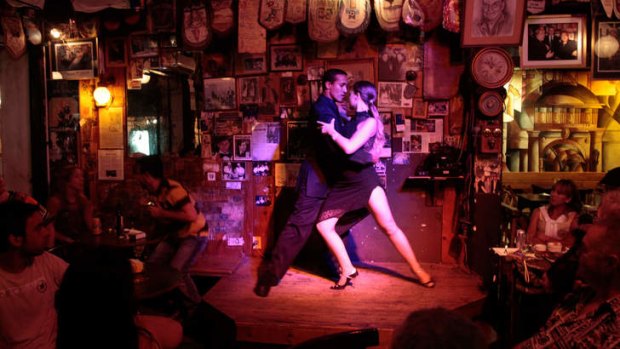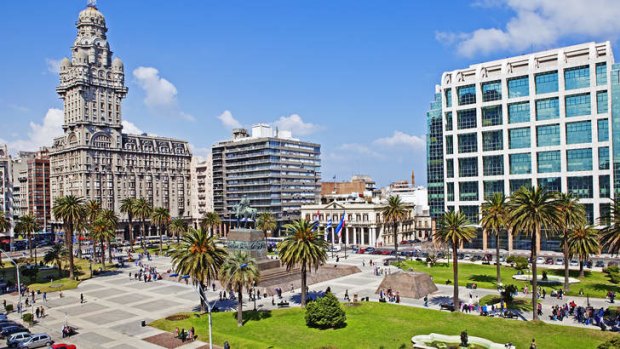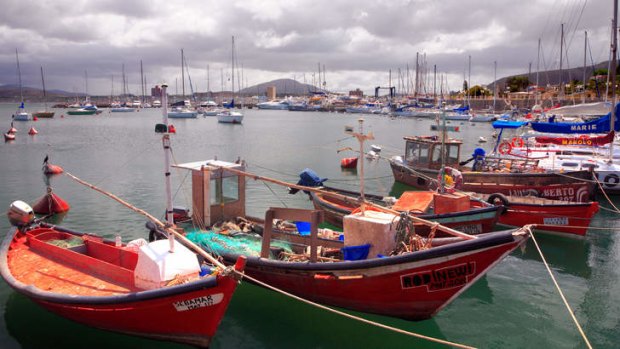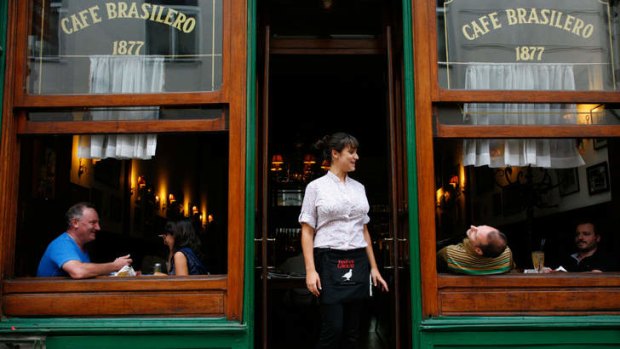
Latin passion: Tango dancers in Montevideo, Uruguay.Credit: Alamy
1 GROWING POPULARITY
Wedged between two South American giants, Uruguay rarely used to feature on travel itineraries. But times are changing. The little neighbour of Argentina and Brazil welcomed 3 million visitors last year - up from 500,000 in 2005. While the resorts on Uruguay's Atlantic coast lure sun-seeking tourists, Montevideo is emerging as one of the continent's coolest capitals, renowned for its architecture, spruced-up old quarters and thriving cultural scene.
2 PROXIMITY TO BUENOS AIRES

Eye-catching: the Palacio Salvo building.Credit: Getty Images
Montevideo is a 45-minute flight from Buenos Aires, the capital of Argentina. But consider riding the ferry across the River Plate - the immense estuary that separates Uruguay and Argentina. Buquebus runs services from BA twice daily, taking just over three hours. Gliding into Montevideo's huge natural harbour, you'll appreciate why it was so coveted by European powers. Claimed by the Spanish in 1726, they had to resist Portugal and Britain to hold it. Ferry fares from 1310 Uruguayan pesos ($59) one-way; buquebus.com
3 AFRICAN BEATS
Most of Montevideo's 1.3 million residents are descendants of Spanish and Italian immigrants, giving the city a strong European feel. This former trans-Atlantic slaving port is also home to a vibrant Afro-Uruguayan community, which comes to the fore during the annual Carnaval. Played out to a backdrop of energetic drum rhythms, known as candombe, it lasts more than 40 days from late January and claims to be the world's longest festival. If you miss this movable feast of parties and parades, peruse the costumes, instruments and masks at Montevideo's Museo del Carnaval, then catch a candombe performance, either open air (try Isla de Flores street in the working-class Palermo barrio) or in a bar like El Tartamudo; eltartamudo.com.uy

Seaside charm: Fishing boats in Piriapolis.Credit: Alamy
4 PLAZA INDEPENDENCIA
Palacio Salvo is the most eye-catching sight on Montevideo's largest plaza. Rising 105 metres, this part gothic, part art deco skyscraper was the continent's tallest building when unveiled in 1928. Salvo apartments are available for rent. At the plaza's core, there is a statue of Uruguayan independence hero Jose Artigas, with his mausoleum below street level. East of Independencia, you'll find the busy Avenida 18 de Julio shopping strip.
5 CIUDAD VIEJA

Lively: Cafe Brasilero in Montevideo.Credit: Alamy
The original fortifications are gone - barring the stone citadel gateway - but an enchanting bygone feel pervades Montevideo's old town. Churches and mansions dating back to the 18th century adorn narrow cobbled streets. After decades of neglect, dozens of buildings have been restored and house smart cafes, hotels, hostels, restaurants and boutiques. Others, all crumbling charm, are crying out for some TLC.
6 HEAD-SCRATCHING ART
Montevideo's best museums spring off Calle Sarandi, the old quarter's main strip. Museo Torres Garcia displays the abstract, cubist art of Uruguay's most famous painter, Joaquin Torres Garcia, a contemporary of Pablo Picasso. A few blocks up, Casa de Rivera offers a potted history of Uruguay with intriguing exhibits such as "head breakers", starfished-shaped stone weapons crafted by tribes 7000 years ago.
7 SNACKING POTENTIAL
You'll get peckish wandering the Ciudad Vieja. For a sugar boost, try churros (doughnuts) or alfajores, sandwich biscuits stuffed with a sticky sweet caramel sauce. Montevideo's Italian heritage means heaps of pizza and pasta joints. There's also the truly monstrous chivito. A toasted bread roll crammed with beef, eggs, cheese, lettuce, tomatoes, olives, bacon, mushrooms, mayonnaise and ketchup, it's so filling that if you scoff it at lunchtime you won't have to eat again til 9pm or 10pm - handy, considering that's when most Montevideanos pop out for their evening meal.
8 MERCADO DEL PUERTO
By the docks, this wrought-iron arcade is jammed with parrillas (barbecue restaurants) serving high-quality beef from cattle reared on Uruguay's grassy pastures. The bife de chorizos (sirloin steaks) are every bit as huge, juicy and tender as those in Buenos Aires. Then there's the parrillada - a jumble of ribs, spicy sausages and offal cuts. Saturday lunchtimes are particularly atmospheric. There's live entertainment and plenty of Medio y Medio quaffing. This champagne-like bubbly is one of Uruguay's signature tipples.
9 LA RAMBLA
Another is mate. Pronounced mah-tay, the stimulating herbal tea derives from yerba, a plant cultivated, long ago, by the indigenous people. You'll see Uruguayans of all ages drinking mate from a flask, via a metal straw, on La Rambla, Montevideo's 22-kilometre waterfront esplanade. Especially appealing at sunset, La Rambla is ideal for a daytime bike ride (hire wheels from El Viajero Ciudad Vieja Hostel; elviajeromontevideo.com). It runs past the city's most desirable suburbs, Pocitos and Carrasco, home to attractive beaches, trendy nightlife and upscale dining. Carrasco's Cafe Misterio has a candle-lit ambience and good sushi; cafemisterio.com.uy
10 PUNTA CARRETAS MALL
Linked to a 26-storey Sheraton hotel, Montevideo's glossiest shopping mall has 200 stores, cinemas and a giant food court. It was converted out of a jail that became notorious during Uruguay's military dictatorship (1973-1985). Political prisoners, including members of the Tupamaros guerrilla movement, were held here. When it opened in 1994, the mall was seen as a symbol of the country's return to democracy. Uruguay is now governed by 79-year-old Jose Mujica, a former Tupamaro.
11 LITERARY LEANINGS
Uruguay boasts the highest literacy rate in Latin America - and some notable writers. One of the most famous, and controversial, is Eduardo Galeano, who was exiled during the dictatorship. His classic, Open Veins of Latin America, is a provocative polemic on how foreign governments, corporations and local elites have exploited the region's natural resources and people. Once banned, it's now a best-seller and received a publicity boost when Venezuelan president Hugo Chavez presented a copy to Barack Obama. In Soccer in Sun and Shadow, Galeano writes of his love for Uruguay's favourite sport. You'll find his stuff in Montevideo's myriad bookshops. Libreria Puro Verso has a fine English selection.
12 CAFFEINE DENS
Uruguay's Italian roots inspire a lively cafe culture. Established in 1877, the bohemian-intellectual Cafe Brasilero (Ituzaingo 1447) has long been the caffeine den of choice for Galeano and contemporaries. There's good coffee at Cafe Irazu (Juan Carlos Gomez 1315), Cake's (Jose Ellauri 1067, Pocitos) and La Pasionaria (lapasionaria.com.uy), a design boutique-cum-art gallery. Sidewalk cafes and bars line Bartolome Mitre - a buzzing stretch after dark.
13 TEATRO SOLIS
The doyen of Montevideo theatres, Solis flaunts Carrara marble columns and gold leaf decorations behind its restored neo-classical face. Admire it on a guided tour, or during a show. Opera, ballet and symphonies are performed here - along with tango. While Argentina is synonymous with this sensual, earthy genre, the godfather of tango, Carlos Gardel, was apparently born in Uruguay before making his name in BA. In 2009, tango made UNESCO's World Heritage list after a joint appeal by both countries; teatrosolis.org.uy
14 FOOTBALL HISTORY
The passionate rivalry between Argentina and Uruguay reaches a crescendo on the football pitch. In 1930, Uruguay beat Argentina 4-2 in the first-ever FIFA World Cup final, held at Estadio Centenario, an arena on Montevideo's outskirts. Built for the inaugural competition and the 100th anniversary of Uruguay's independence, it exudes a faded grandeur, but still hosts games (fierce city foes Penarol and Nacional duel here), and has a nostalgia-inducing museum of footballing memorabilia (open Monday-Friday, 10am-5pm).
15 STIRRING VIEWPOINTS
The soaring, shiny Torre Antel telecommunications tower looks as if it's been plucked out of Dubai. Rising 158 metres over Montevideo's bay, it's Uruguay's tallest building and has wonderful views from its observation deck. At the other side of the bay, magnificent panoramas can be savoured from the General Artigas fortress. The cannonball-studded ramparts nudge an intriguing military museum, with antique weapons and portraits of stern men with impressive facial hair.
16 WINERIES
Argentina has malbec. Uruguay has tannat. A dry, bold red wine, it's made from grapes brought to Uruguay by a Basque in the late 19th century and accounts for a third of the country's wine exports. Sample award-winning tipples at family-run wineries on Montevideo's edges, such as Bouza Bodega Boutique, housed in a French-style chateau. After a tour and tastings, dine on lamb, beef or Patagonian toothfish at the elegant restaurant; bodegabouza.com
17 GAUCHO CULTURE
Beyond the bodegas lie the pampas, the great rolling plains that spawned the gaucho. Once nomadic horse-riders, these rugged South American cowboys have settled on farms and ranches, many breeding cows and sheep (for meat and dairy products, and hides and wool). Some offer tourist accommodation and activities. Montevideo-based Lares specialises in estancia tourism (lares.com.uy). Montevideo has a museum dedicated to gaucho folklore (Avenida de Julio 998).
18 CASAPUEBLO
The Atlantic coast east of Montevideo is dotted with quirky architecture. Piriapolis, an unpretentious seaside resort built in the 1930s, has a few once opulent hotels. Nothing, however, can match Casapueblo. A surreal sculpture-hotel created by Uruguayan architect Carlos Paez Vilaro, it's like a cross between Gaudi's work in Barcelona and the whitewashed villas of the Greek islands. Crawling nine stories up a cliffside, it boasts swimming pools, a spa, restaurant and terrace with amazing sea views (sunsets are divine) and a handful of rooms showcasing Vilaro's artwork - plus 42 more to sleep in; doubles from $US121 ($130); clubhotelcasapueblo.com
19 THE PUNTAS
Casapueblo is 15 kilometres west of Punta del Este, a super-hip seaside resort that attracts a rich and beautiful jet set (especially from Argentina) between December and February. The so-called St Tropez of South America is ghost town-like in winter. Further afield, the idyllic village of Jose Ignacio lures a sophisticated crowd (including supermodel Gisele Bundchen), then there's a string of less developed, but increasingly popular, beaches, at Cabo Polonio and Punta del Diablo, which cater for surfers, backpackers and wildlife watchers (sea lions and whales frolic offshore).
20 COLONIA DEL SACRAMENTO
In the opposite direction, a two-hour drive west of Montevideo, Colonia is Uruguay's prettiest town. Founded in 1680 by the Portuguese as a port to smuggle goods to Spanish-held Buenos Aires, it was long fought over by forces loyal to Lisbon and Madrid. This is reflected in the varied architecture sprinkled along the sleepy, bougainvillea-shaded cobbled streets. Colonia is a delight at all times, but oozes a different kind of magic when the day-trippers have returned to BA - a 75-minute ferry ride away.
Sign up for the Traveller Deals newsletter
Get exclusive travel deals delivered straight to your inbox. Sign up now.